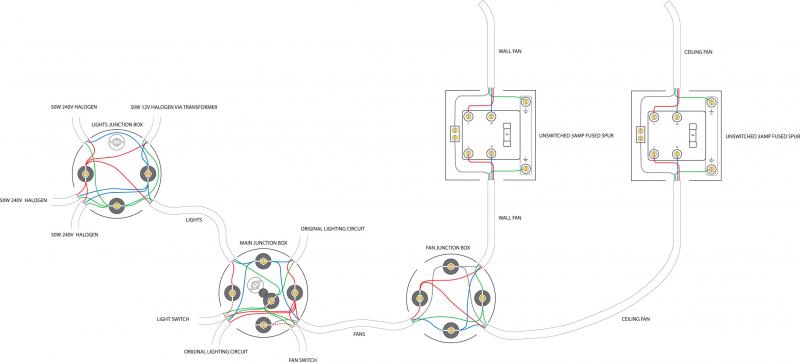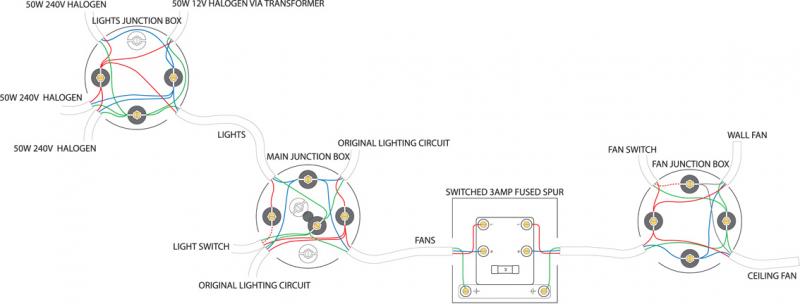I'm fitting new lights and fans to my bathroom and I've come across a few questions I'd really appreciate help in having answered. Can I also say I'm not an electrician but I am having the wiring looked at as required to check the safety and regs-compliance etc. but I am intent on doing the work myself. I really enjoy learning new skills and understanding things better! 
Basically, I am installing a wall fan with timer module, a shower fan with timer, 3 x 50W 240v Halogens and 1 x 12v Halogen with it's own transformer (due to the 12v halogen and the shower fan being a single unit - although the fan is powered seperately of course). I've installed plenty of lights in the past so no questions there, but the fans are new to me.
I learnt about how fans with timer modules have Neutral, Permanent Live and Switched Live and that's all fine too, but I am a little confused when it comes to installing a 3amp fused spur on each of the extractor fans. Both fans instruction manuals point out that these are required. I have been to a number of DIY outlets looking for a 3amp fused spur but only found 13amp fused spurs available - I'm guessing this is really simple, but I'd rather be sure I'm not doing it wrong - so is it just a simple case of swapping the 13amp fuse out for a 3amp fuse? Secondly, I initially assumed that both the Permanent Live and the Switched Live should be fused, but the fans instructions only shows the Permanent Live being fused. How is that wired up inside the Fused Spur Box? The Fused Spur provides terminals for Live, Neutral and Earth, but in this case there is no Earth, so is it a case of wiring the Permanent Live into Live, the Neutral into Neutral, ignoring the Earth and using a Connector Block to continue the Switched Live to the fan?
Oh, and one last question (probably daft, but I'm really curious)... I plan to purchase two fused spurs, one for each fan, but is it legally possible and safe to wire the two fans into one 3amp fused spur?
Sorry for the long post and thanks for taking the time to read this and provide your advice.
Basically, I am installing a wall fan with timer module, a shower fan with timer, 3 x 50W 240v Halogens and 1 x 12v Halogen with it's own transformer (due to the 12v halogen and the shower fan being a single unit - although the fan is powered seperately of course). I've installed plenty of lights in the past so no questions there, but the fans are new to me.
I learnt about how fans with timer modules have Neutral, Permanent Live and Switched Live and that's all fine too, but I am a little confused when it comes to installing a 3amp fused spur on each of the extractor fans. Both fans instruction manuals point out that these are required. I have been to a number of DIY outlets looking for a 3amp fused spur but only found 13amp fused spurs available - I'm guessing this is really simple, but I'd rather be sure I'm not doing it wrong - so is it just a simple case of swapping the 13amp fuse out for a 3amp fuse? Secondly, I initially assumed that both the Permanent Live and the Switched Live should be fused, but the fans instructions only shows the Permanent Live being fused. How is that wired up inside the Fused Spur Box? The Fused Spur provides terminals for Live, Neutral and Earth, but in this case there is no Earth, so is it a case of wiring the Permanent Live into Live, the Neutral into Neutral, ignoring the Earth and using a Connector Block to continue the Switched Live to the fan?
Oh, and one last question (probably daft, but I'm really curious)... I plan to purchase two fused spurs, one for each fan, but is it legally possible and safe to wire the two fans into one 3amp fused spur?
Sorry for the long post and thanks for taking the time to read this and provide your advice.



